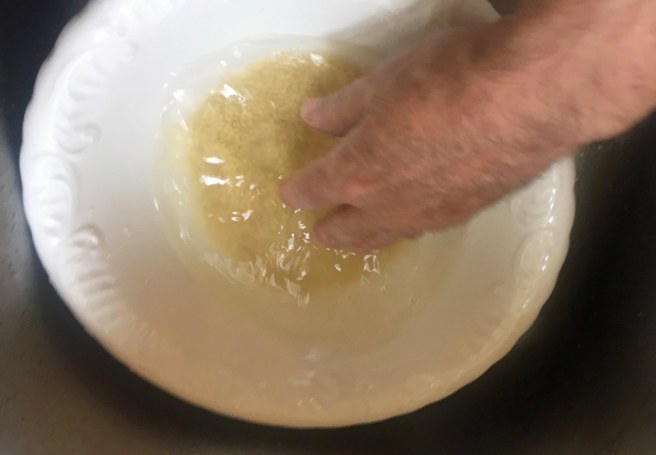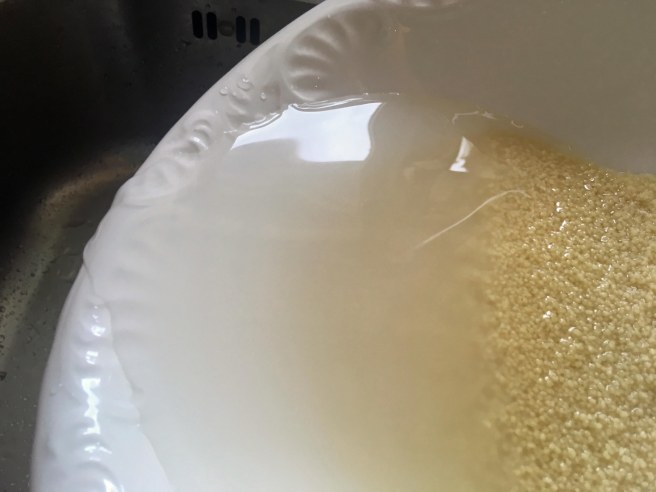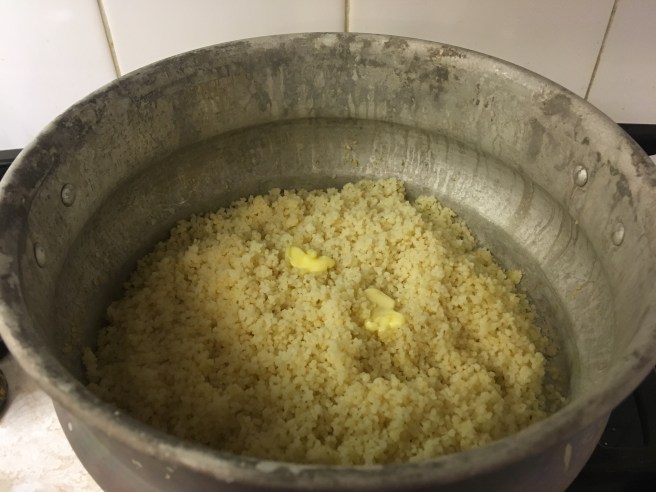For many people, and the odd donkey, 7 is a lucky number. The recipe that follows must be very lucky indeed as DonQui makes it with seven vegetables and seven spices.

This is DonQui’s take on a traditional couscous from Fez, adapted from Paula Wolfert’s excellent book: Couscous and Other Good Food from Morocco. DonQui’s recipe differs from the traditional in two ways.
Firstly he uses no meat while the original contains both chicken and lamb. This is not because DonQui is a vegetarian — he is anything but. Rather it is because he is cooking for just two people, not a vast horde, and very occasionally he likes to experiment with vegetable dishes.
Secondly he likes his vegetables crisp and crunchy while the vegetables in most traditional Moroccan couscouses are cooked to the point where they are soft and soggy. This is because the vegetables (and meat) are used to produce a deep rich bouillon. It is the sauce that is important rather than the the individual ingredients that are used to make it. DonQui’s recipe tries to balance both — crisp, crunchy vegetables as well as a deep rich sauce.
Ingredients (for two people)
1 cup of dry couscous
500 ml chicken stock
500 ml lamb stock
1 small tin (250 g) of chopped tomatoes or 2 fresh large tomatoes peeled and chopped
a bunch of chopped coriander leaves (cilantro)
a bunch of chopped parsley
½ cup of dry chickpeas (garbanzo beans) soaked overnight
a handful of raisins
a handful of blanched almonds
salt to taste
harissa to taste
lemon juice to taste
a mix of butter and oil for frying

½ tsp ground coriander seed
½ tsp ground cumin seed
½ tsp turmeric
½ tsp dry ground ginger
1 cinnamon stick
1 tsp ground black pepper
a pinch of saffron threads

DonQui parts from tradition here, using whatever is fresh and available as well giving a good colour balance rather than sticking to traditional Moroccan vegetables. This time he uses:
1 onion, finely chopped
1 small courgette (zucchini)
4 baby sweet corn
6 sprigs of tender stem broccoli
3 carrots
a handful of fine french beans
a bunch of broad beans (later podded).
The onion is essential but the other vegetables are entirely up to your taste. Turnip is a traditional vegetable in Moroccan couscous and it adds a nice peppery flavour to the sauce. Unfortunately there were none available in his local shop when he made this dish. Normally he would try to include it.
Notes:
DonQui uses a combination of chicken and lamb stock as the traditional recipe is made with both chicken and lamb. He sometimes uses only chicken stock. Alternatively if you want a vegetarian dish then you could use 1 litre of vegetable stock instead.
To peel fresh tomatoes, place them in a bowl and pour boiling water over them. Let them sit for a few minutes and the skins will come off. It is easier if you quarter the tomatoes before peeling.
Method
Note: This dish takes several hours preparation. DonQui usually starts in the morning for an evening meal. Most of the more complicated stages can be done well in advance to leave the final preparations to the last 30 minutes.

Prepare the dry couscous by washing and drying as described in step 1 of How to Make the Perfect Couscous. This should be done several hours in advance.
Drain the chickpeas and simmer in boiling water for 1 hour. Then drain.

In the bottom of a couscousiere gently fry the chopped onion in the butter and oil until it begins to colour. DonQui also likes to add one chopped carrot as well.

When the onion-carrot mix begins to colour but before it burns, add the chickpeas and all the spices. Stir for about a few seconds over a medium heat.

Add the tomatoes, salt, coriander and parsley, stirring continuously so that the mix is well blended but does not scorch. The add the stock and bring to the boil.

Place the couscous in the top half of the couscousiere and steam over the mixture for 20 minutes as described in step 2 of How to Make the Perfect Couscous. Up to this point everything can be done well in advance and it is better to do so. You can then set everything off to one side and make the final preparations without time-stress.
Thirty minutes before you wish to serve, add the raisins to the mixture in the bottom of the couscousiere and bring back up to the boil. Place the pre-prepared couscous back on top to steam another 20 minutes as described in step 3 of How to Make the Perfect Couscous.
The original 1 litre of stock will have reduced considerably by the end of this stage but it should be enough to continue to steam the couscous while forming a rich broth. If it looks like it is evaporating too much then add a little water.
Gently fry the blanched almonds in butter until they turn a golden brown. Tip out on a plate covered with paper towels to dry and set aside to dry.

Meanwhile prepare the fresh vegetables by cutting the larger ones (carrots and courgette) into julienne style batons about 3 cms long. Cut the french beans in half widthwise and slice larger baby corn in half lengthwise. Cut off the thicker parts of the broccoli stalks. Although not essential, broad beans are best if you remove the outer skin of the individual beans after podding. This is best done by blanching for a minute or two, pinching an opening in the outer skin and then squeezing the tender inner bean through it.
When the couscous has steamed for 20 minutes add the carrots to the broth and continue to simmer for 2 minutes more. Then add the baby corn, broccoli and beans, and simmer for 3 minutes. Finally add the courgette for a final 2 minutes. In this way the carrots will have cooked for 7 minutes, the beans and corn 5 minutes and the courgette for 2 minutes. Adjust your cooking times to the individual vegetables and your taste. DonQui likes his still a bit crunchy and these timings give him that.

Tip the couscous out onto a serving platter. Fluff up with a fork (possibly adding a few dollops of butter) and form a well in the centre for the vegetables.
Strain the vegetables, reserving the broth. Tip the drained vegetables into the well of the couscous.

Pour the strained broth back into the bottom of the couscousiere. Bring back up to the boil and immediately take off the heat. Add a dollop of harissa and a squeeze of lemon juice to taste and stir well. Taste for seasoning and pour the broth into a serving jug or gravy boat.

Sprinkle the vegetables with the fried almonds and serve with the broth on the side.

















